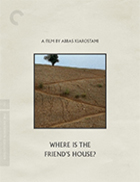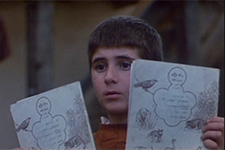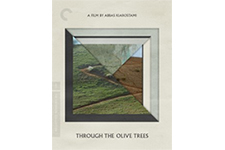| Director: Abbas Kiarostami | | Screenplay: Abbas Kiarostami | | Stars: Babek Ahmed Poor (Ahmed), Ahmed Ahmed Poor (Mohamed Reda Nematzadeh), Khodabakhsh Defaei (Teacher), Iran Outari (Mother), Ait Ansari (Father), Sadika Taohidi (Perzian Neighbour), Biman Mouafi (Ali, a neighbor), Ali Djamali (Grandfather’s Friend), Aziz Babai (Waiter), Nader Ghoulami (Property Owner), Akbar Mouradi (Old Man from Azerbaidjan) | | MPAA Rating: NR | | Year of Release: 1987 | | Country: Iran |  |
|  Abbas Kiarostami’s Where is the Friend’s House? is, like the neorealist works from which it descends, deceptively simple and utterly profound. The story of a young boy who lives in rural Iran attempting to return a notebook to a classmate from a neighboring village, it fulfills the admonition of neorealist theoretician Cesare Zavattini that “the artist’s task is not to make people moved or indignant at metaphorical situations, but to make them reflect (and, if you like, to be moved and indignant too) on what they and others are doing, on the real things, exactly as they are.” Kiarostami spent much of his early career in the 1970s and early ’80s making documentaries, and his eye for “real things, exactly as they are” is particularly tangible in Where is the Friend’s House, which conveys the essence of its characters’ lives in direct, broad strokes that are neither obtrusively cinematic nor faux-documentary. Instead, Kiarostami finds a perfect middle ground, a delicate, poetic balance of telling a fictional story in a way that feels simply captured, rather than constructed. The story takes place over a 24-hour period, beginning at a rural schoolhouse where we are introduced to the protagonist, 10-year-old Ahmed (Babek Ahmed Poor), whose bright eyes, small, tight mouth, and narrow face convey an intensity of purpose that feels years beyond his youth, yet maintains a genuine, endearing naivete. The schoolteacher (Khodabakhsh Defaei), a stern, humorless man, makes it clear to Ahmed’s desk-mate, Mohamed (Ahmed Ahmed Poor), that, should he arrive at school the following day without his notebook, he will be expelled. When Ahmed goes home that afternoon, he discovers that he has accidentally taken Mohamed’s notebook home with him, and he feels compelled to return it to him, even though he lives in a neighboring village of Poshteh. He tries to tell his mother (Iran Outari), but she refuses to listen to him—a recurring theme throughout the film. Although she instructs him to go to the market to buy bread, he instead leaves for Poshteh, hoping he can figure out where Mohamed lives so he can return the notebook. That turns out to be much easier in concept than execution, as Poshteh is a sprawling village of similar-looking adobe houses with no numbers and markings. The people living there are mostly unhelpful, but not deliberately so, and as the afternoon grows late, it seems more and more likely that Ahmed will fail in his earnest mission. Within that simple narrative framework, which borrows such classical narrative conventions as the goal-oriented protagonist and the deadline without ever feeling fabricated, Kiarostami evokes a deep well of fundamental human decency. In a world with so much cruelty and lack of empathy for our fellow human beings, Kiarostami has crafted a simple, but elegant paean to the revolutionary idea of doing the right thing for its own sake. Ahmed feels responsible for taking the notebook and realizes that his friend will be expelled if he doesn’t do something about it. He could have easily sat back and done nothing (and possibly even blamed Mohamed for not making sure he had his notebook before leaving school), but instead he takes it upon himself to correct the situation, even though it puts him at risk of getting in trouble. Like Albert Lamorisse’s The Red Balloon (1956), Ken Loach’s Kes (1969), and Steven Spielberg’s E.T. The Extra-Terrestrial (1982), Where is the Friend’s House? is told purposefully from a child’s point of view—not, I emphasize, a childish point of view. Seeing the world through Ahmed’s clear sensibility and forthright determination allows us to regain a sense of humanity that is all too often lost in the modern rush for attention and victory. Ahmed just wants to do what’s right, and Kiarostami’s film reminds us of how profoundly beautiful that can be. | Where is the Friend’s House? Criterion Collection Blu-ray |  Where is the Friend’s House is available as part of “The Koker Trilogy” boxset, which also includes And Life Goes On (1992) and Through the Olive Trees (1994). Where is the Friend’s House is available as part of “The Koker Trilogy” boxset, which also includes And Life Goes On (1992) and Through the Olive Trees (1994). | | Aspect Ratio | 1.66:1 (all three films) | | Audio | Persian Linear PCM 1.0 monaural (all three films) | | Subtitles | English | | Supplements | Where is the Friend’s House?Homework (1989), a feature-length documentary by KiarostamiConversation from 2015 between Kiarostami and programmer Peter ScarletAnd Life Goes OnAudio commentary by Mehrnaz Saeed-Vafa and Jonathan Rosenbaum, coauthors of Abbas KiarostamiAbbas Kiarostami: Truths and Dreams (1994) documentaryVideo interview with scholar Hamid NaficyThrough the Olive TreesVideo interview with director Kiarostami’s son Ahmad KiarostamiConversation between scholar Jamsheed Akrami and critic Godfrey Cheshire | | Distributor | The Criterion Collection | | SRP | $99.95 | | Release Date | August 27, 2019 | | | COMMENTS | | All three films in “The Koker Trilogy” have been given new high-definition transfers made from the original 35mm camera negatives (Where is the Friend’s House? and And Life Goes On were transferred in 2K, while Through the Olive Trees was transferred in 4K). Of the three films, Where is the Friend’s House? is the only one to show any signs of wear and tear, as a number of scenes have vertical damage down the righthand side of the frame. It is never terribly intrusive and clearly could not be corrected without introducing additional artifacting into the image. It is primarily evidence of how Kiarostami’s films were probably not being treated and stored with the level of care they are now because he was not yet an international name in world cinema. The image still looks good otherwise, with strong detail and contrast and plenty of lively film grain. The same can be said for And Life Goes On and Through the Olive Trees, both of which look slightly sharper and more polished. The monaural soundtracks for the first two films in the trilogy were transferred from the 35mm soundtrack negatives, while the soundtrack for Through the Olive Trees was transferred from the 35mm magnetic tracks. All were digitally restored and sound fine. The supplementary material spread across the three discs in the set is quite impressive. On Where is the Friend’s House? we have Abbas Kiarostami’s feature-length 1989 documentary Homework, which has been transferred from the original 16mm negative. In the film, Kiarostami interviews parents and their children at the Martyr Masumi Grade School in Tehran. The disc also contains a 2015 interview with Kiarostami by film programmer Peter Scarlet that was recorded in Toronto (a year before Kiarostami passed away). The And Life Goes On disc includes an informative new audio commentary by Mehrnaz Saeed-Vafa and Jonathan Rosenbaum, who together wrote Abbas Kiarostami, which was just published in an expanded second edition in 2018. Through the commentary they offer lucid insights into the film’s style and its place in Kiarostami’s career. Also on the disc is Abbas Kiarostami: Truths and Dreams, a nearly hour-long documentary from 1994 by Jean-Pierre Limosin that was originally broadcast on French television as an episode of Cinema, de noire temps. Finally, there is a 15-minute interview with Hamid Naficy, author of A Social History of Iranian Cinema in which she talks about Kiarostami’s place in the “New Iranian Cinema.” The third disc in the set, Through the Olive Trees, features a 15-minute interview with the director’s son, Ahmad Kiarostami, who offers personal insight about his father’s experiences making the films in the Koker Trilogy, and a 20-minute conversation between Iranian film scholar and documentarian Jamsheed Akrami and film critic Godfrey Cheshire, who recently published an anthology of interviews titled Conversations With Kiarostami (2019). |
Copyright © 2019 James Kendrick Thoughts? E-mail James Kendrick All images copyright © The Criterion Collection |




 (4)
(4)

 Where is the Friend’s House is available as part of “The Koker Trilogy” boxset, which also includes And Life Goes On (1992) and Through the Olive Trees (1994).
Where is the Friend’s House is available as part of “The Koker Trilogy” boxset, which also includes And Life Goes On (1992) and Through the Olive Trees (1994).